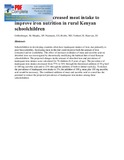The potential of increased meat intake to improve iron nutrition in rural Kenyan schoolchildren

View/
Date
2007Author
Grillenberger, M
Murphy, SP
Neumann, CG
Bwibo, NO
Verhoef, H
Hautvast, JG
Type
ArticleLanguage
enMetadata
Show full item recordAbstract
Schoolchildren in developing countries often have inadequate intakes of iron, due primarily to poor bioavailability. Increasing meat in the diet could improve both the amount of iron consumed and its availability. The effect of increases in intakes of meat and ascorbic acid on absorbed iron was investigated by theoretically modifying the habitual diet of rural Kenyan schoolchildren. The projected changes in the amount of absorbed iron and prevalence of inadequate iron intakes were calculated for 78 children (6-9 years of age). The prevalence of inadequate iron intakes decreased from 77% to 54% through the theoretical addition of 50 g beef or 100 mg ascorbic acid and to 23% through the addition of both to dinner each day. To reduce the prevalence of inadequate iron intake to 5%, the addition of 100 g meat plus 150 mg ascorbic acid would be necessary. The combined addition of meat and ascorbic acid to a meal has the potential to reduce the projected prevalence of inadequate iron intakes among these schoolchildren
URI
http://www.ncbi.nlm.nih.gov/pubmed/18214020http://erepository.uonbi.ac.ke:8080/xmlui/handle/123456789/15959
Citation
Int J Vitam Nutr Res. 2007 May;77(3):193-8Publisher
Division of Human Nutrition, Wageningen University, Wageningen, The Netherlands Department of Biostatistics, School of Public Health, University of California, Los Angeles, CA, USA: Department of Paediatrics and Child Health
Collections
- Faculty of Health Sciences (FHS) [10378]
